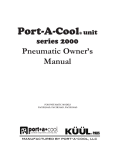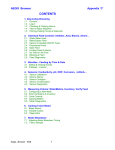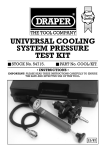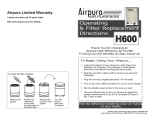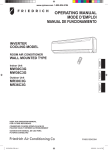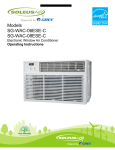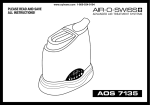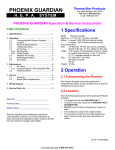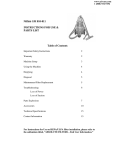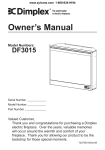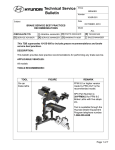Download Port-A-Cool 16-Inch Pneumatic Evaporative Cooler User Manual
Transcript
www.sylvane.com 1-800-934-9194 Port-A-Cool ® unit series 2000 Pneumatic Owner’s Manual FOR PNEUMATIC MODELS PAC2K36AD, PAC2K24AD, PAC2K16AD ® manufactured by port-a-cool, llc www.sylvane.com 1-800-934-9194 PORT-A-COOL® unit OWNERS MANUAL PNEUMATIC MODELS PAC2K36AD, PAC2K24AD, PAC2K16AD I. SETUP A. Unpacking the PORT-A-COOL® unit. B. Removing the cooling pads. C. Connecting the water and air. II. OPERATING PROCEDURES A. Placement of the PORT-A-COOL® unit. B. Filling with water C. Starting the pump and adjusting the water flow. D. Starting the fan. III. MAINTENANCE & STORAGE A. Daily Maintenance B. Weekly Maintenance C. Storage IV. TROUBLESHOOTING A. Troubleshooting V REPLACEMENT PARTS A. Ordering Replacement Parts VI. EVAPORATIVE COOLING A. What is Evaporative Cooling? B. Humidity and Evaporative Cooling. C. Evaporative Cooling and the PORT-A-COOL® unit. www.sylvane.com 1-800-934-9194 I. SETUP A. Unpacking the PORT-A-COOL® unit. The pneumatic PORT-A-COOL® unit models ( PAC2K36AD, PAC2K24AD, PAC2K16AD), are packed according to the model. The 36” reaction fan model (PAC2K36AD) is crated on a wooden pallet. This model comes completely assembled and thus weighs in excess of 460 lbs. It should be handled with caution . The 24” and 16” models ( PAC2K24AD, PAC2K16AD) are shipped in one large package on a single pallet. The air mover is in an individual package. These two models require assembly before operating. See page A-l for assembly information. B. Removing the cooling media. (Disconnect air source) Caution - Disconnect air supply before performing this operation!! The PORT-A-COOL® unit should now be exposed to allow removal of the cooling media (pads). On the 36” and 24” model, the front flap and the pad screen ( if installed) must be removed to allow access to the cooling pads. Start with the center pad, which should be tilted out from the top and lifted out of the drain trough. The two pads to either side of the center pad may then be removed in the same manner. Should you desire to remove the two outside pads, they must first be pulled sideways toward the center of the PORT-A-COOL® unit until they clear the side retainer. They may then be removed as the other pads. C. Connecting the water and compressed air. Water Connection (PORT-A-COOL® unit must be upright and sitting on a stable surface.) After the PORT-A-COOL® unit has been thoroughly tested at the factory, the special female/female adapter is connected to the brass bulkhead connector on the left side of the PORT-A-COOL® unit (when looking at the fan side). Simply attach a standard garden hose to the brass female/female adapter. Verify that the rubber hose washer is in place before attaching, and tighten the fitting to guarantee that a secure connection is made. Once the hose connection is made, water may be turned on to the PORT-A-COOL® unit. Water should now be entering through the float valve to fill the sump tank. To verify that your connections are well made, manually lift the float (in all models) in the float valve until it seats against the top of the valve housing. The water flow should stop and the inlet connections may now be visually checked for leaks, paying particular attention to the hose connection to the float valve and the connections to the bulkhead fitting, these connection may loosen during shipment. The cooling pads may now be replaced by reversing the removal operation above in Section I, Paragraph B. 1 www.sylvane.com 1-800-934-9194 Compressed Air Connection WARNING: use extreme caution when connecting or disconnecting compressed air!! Before connecting compressed air to the PORT-A-COOL® unit be sure that both the Jet Fan or Air Mover and the Pump shut-off valves are closed. The air is connected by way of a Crow’s foot type bayonet connector. This connection is made by placing the matting together where the rubber seals are touching and then twisting the input hose connector 90 deg. clockwise while pressing the two fittings together. A pin should then be inserted into the two holes to provide a secure and safe attachment. INLET PRESSURE FLOW RATE AIR FLOW MODEL# PAC2K36AD 80 PSI l96 scfm 9,100 cfm PAC2K24AD 40 PSI 164 scfm 4,898 cfm PAC2K16AD 40 PSI 83 scfm 2,200 cfm AIR DRIVE CONSUMPTION RATES 2 www.sylvane.com 1-800-934-9194 II. OPERATING PROCEDURES A. Placement of the PORT-A-COOL® unit. PORT-A-COOL® unit should be used in well ventilated areas only. There are three primary considerations when deciding where to place the PORT-A-COOL® unit. 1) Fresh Air Supply - The rear of the PORT-A-COOL® unit (pad area) must be placed so as to insure a smooth, uninterrupted supply of fresh air. 2) Air Pattern - The cool air discharged from the PORT-A-COOL® unit should have a clear area to circulate in, as free of obstruction as possible. 3) Ventilation (Exhaust} - There should be a defined place in which the air from the PORT-A-COOL® unit can be exhausted from the area being cooled. This is to prevent the PORT-A-COOL® unit from recirculating air that has already been through the cooling process. A primary consideration when actually deciding where to place PORT-A-COOL® unit is the direction of the air flow. The PORT-A-COOL® unit creates a fan-shaped air pattern that disburses the air over a large area. This pattern may be disturbed or broken up by obstacles such as shelves, work benches, etc. It is important to insure that a clean, unbroken path for the air from the PORT-A-COOL® unit is provided to ensure the maximum circulation possible. It may be desirable to raise the PORT-A-COOL® unit above any low obstructions in order to increase the overall coverage. When raising the height of the PORT-A-COOL® unit, insure that the platform constructed for holding the PORT-A-COOL® unit is stable, well constructed, level and will not allow the PORT-A-COOL® unit to tip over. The PORT-A-COOL® unit must be level on its base. When the PORT-A-COOL® unit is placed near a wall or other obstruction, it is recommended that a distance of at least 3 feet from the wall or obstruction to the face of the cooling pads is maintained. This allows the unrestricted flow of warm air to the front of the PORT-A-COOL® unit. When using multiple PORT-A-COOL® unit units in close proximity, be sure to aim the PORT-A-COOL® unit so that the air flows compliment each other. Opposition will negate the air flow and allow an area of dead air to accumulate between the two or more PORT-A-COOL® unit units. B. Filling with water. Refer to Section I, Part D, and connect the water supply line. Turn on your supply valve and allowing the PORT-A-COOL® unit sump tank to fill with water. Once the sump tank is full, the float valve will shut off the supply flow. 3 www.sylvane.com 1-800-934-9194 C. Starting the pump and adjusting the water flow (pads should be in place). CAUTION - DO NOT RUN PUMP WHEN SUMP IS DRY. Once the sump tank is full, the pump may be started by opening the pump valve which is the smaller of the two 1/4 turn air valves. With this valve open the amount of water may be adjusted by using the pneumatic flow control valve to obtain the desired amount of water placed on the pads. This procedure is the same on all pneumatic models. Spray bar valve must be open. When, initially turning on the pump, the level in the sump will drop suddenly and restart the flow of supply water. This is a normal condition as the cooling pads require a large amount of water for proper wetting. When the PORT-A-COOL® unit is new, the new pads will require an initial ‘breaking-in’ period. This period is required to start the pads absorbing the water into the paper. It may take up to a week before maximum efficiency is reached. D. Starting the fan/air mover. (Cooling pads must be installed and caster brakes must be engaged.) CAUTION - MAKE SURE THE GREEN GROUND LINE ATTACHED TO THE PORT-A-COOL IS ATTACHED TO A GOOD GROUND TO ELIMINATE STATIC ELECTRIC CHARGES. Only the 36” reaction fan model (PAC2K36AD) has a rotating fan to move the air. This unit is started by slowly opening the large 1/4 turn air valve on the control panel on the side of the unit. The regulator is preset at the factory to obtain maximum output. This 1/4 turn air valve may be adjusted to provide the required output. The 24” and 16”models (PAC2K24AD & PAC2K16AD) utilize a venturi air amplifier to accomplish the air movement required. These units are also factory adjusted to the maximum pressure/flow rate. This 1/4 turn air valve may be adjusted to provide the required output. With the air & pump on and the pads wet, it is now possible to make fine adjustments to the water flow for maximum cooling performance. Adjust the flow where the pads appear to have a few dry streaks in them. This condition of having a few vertical dry streaks in the pads indicates that the supply of water is sufficient to the pads without being extreme. When turning the unit off at the end of the day or week, the pump should be turned off about 15 minutes before the air movement system to allow the cooling pads to dry. This will enhance the life of the pads. 4 www.sylvane.com 1-800-934-9194 III. MAINTENANCE & STORAGE Very little maintenance is actually required on the PORT-A-COOL® unit. Most of the maintenance on the PORT-A-COOL® unit is cleanliness. Keeping the PORT-A-COOL® unit clean will do more than any other single item to keep your new PORT-A-COOL® unit in peak operating condition. The rugged, corrosion-resistant construction of the PORT-A-COOL® unit and industrial grade components make for the low maintenance characteristics of the PORT-A-COOL® unit. A. Daily Maintenance Daily maintenance is really more an operational consideration than actual maintenance. On a daily basis, the pump should be turned off approximately 15 minutes before the fan is turned off. This will allow the cooling pads to dry out and help extend their life, helping to control the growth of mildew, mold, bacteria and other odor causing elements. B. Weekly Maintenance At the end of the week or at a scheduled time, the unit should be shut down and the sump tank should be drained. On the 36- and 24-inch models, this is accomplished by closing the Spray Bar Adjustment Valve and opening the Drain Valve. If it is desired, a hose may be attached to the Drain Valve to direct the drained water to a remote disposal area. Once the Drain Valve is open, starting the pump will drain the unit. On the 16-inch model, a simple drain plug in the sump tank may be removed and the sump drained. Once the sump is drained and the power disconnected, the pads may be removed to allow inspection of the sump tank. Assuming that the PORT-A-COOL® unit is in a dusty environment, a lot of the dust will be collected in the sump tank. This dirt may be vacuumed out using a wet/dry shop vacuum and wiped clean with a cloth. C. Storage Storage of the PORT-A-COOL® unit is very simple. 1) Drain all water from the sump tank and clean as above, ensuring that the pads and sump are completely dry. 2) Disconnect air supply hose and roll up to insure that they will not be rolled over, tripped over or caught in equipment. 3) Cover the PORT-A-COOL® unit completely to prevent dust build-up and store in a dry area. This also helps prevent damage to the pads. 5 www.sylvane.com 1-800-934-9194 IV. TROUBLESHOOTING / REPAIR CAUTION: DISCONNECT AIR SUPPLY BEFORE REMOVING PAD GUARD OR COOLING PADS FROM THE PORT-A-COOL® unit. A. Troubleshooting The most common problems with a PORT-A-COOL® unit are operational, meaning that the PORT-A-COOL® unit does not operate properly. The PORT-A-COOL® unit consists of three systems. It is important to determine which system of the PORT-A-COOL® unit the problem is associated with. This may not always be obvious in that certain problems may be associated with more than one system. When determining which system that the problem is associated with, you must first define the problem, i.e. the pump is not operating. Although this might seem a bit oversimplified, this particular problem may be caused by several things. So while defining the problem, a careful check of all systems should be made to fully understand the extent of the problem. If you are having difficulty determining the exact problem it is best to contact the distributor from whom the PORT-A-COOL® unit unit was purchased. The distributors are factory trained and will be able to have your PORT-A-COOL® unit unit repaired quickly. V. REPLACEMENT PARTS Warranty Replacement Parts Replacement-parts may be acquired from the distributor from which you purchased the PORT-A-COOL® unit. If you are not certain from whom the PORT-A-COOL® unit was purchased please call the Port-A-Cool, LLC Technical Support Hot Line (888-266-5243) or email Tech Support at [email protected] and have the serial number of your unit ready. The serial number will help us determine whom the appropriate distributor is, the model of PORT-A-COOL® unit and how best to locate the required parts. Non-Warranty Replacement Parts Again replacement parts should be ordered from the distributor from which you purchased the PORT-A-COOL® unit. If you are unable to acquire the necessary parts please call the Technical Support Hot Line (888-266-5243)(U.S. only) or email Tech Support at [email protected] for the nearest stocking distributor. 6 www.sylvane.com 1-800-934-9194 VI. EVAPORATIVE COOLING The PORT-A-COOL® unit is a fully self-contained, portable, high efficiency evaporative cooler. The PORT-A-COOL® unit is proudly made in America at our Center, Texas factory. A. What is Evaporative Cooling? When trying to understand evaporative cooling, it may be best to think of air as being like a sponge. Similar to a sponge, air has an ability to absorb moisture that it comes in contact with. The amount of moisture that the air will absorb depends on the condition of the air, or specifically, how much moisture the air already contains and the temperature of the air. If the air is warm and contains only a small amount of moisture, it will more readily absorb moisture. As air cools, its volume decreases, and with it, its ability to absorb moisture decreases. After all, how easily you can clean up a spill depends on how dry the sponge is that you are using. The term “relative humidity” describes the quantity of water in the air in relation to its total capacity. Any volume of air at any given temperature has an ability to hold a certain quantity of moisture. If the air contains 20% of its total capacity to hold moisture, the relative humidity is said to be 20%. Whereas, a humidity of 100% indicates that the air at this temperature and pressure is holding all the moisture it can. If the air has a low relative humidity when entering the PORT-A-COOL® unit, then it has the ability to hold more moisture, and will thus evaporate more water and cool more effectively. When describing the amount of moisture in the air, the term relative humidity is used because the “sponginess” of air changes relative to air temperature. The warmer the air, the more spongy it becomes, and the more water it can hold. That is to say that air that has a 100% relative humidity can hold no more water vapor. However, if the air is heated’ it expands, and as a result the relative humidity decreases even though the total amount of water vapor in the air has not changed. As a result, we must describe the level of humidity relative to the condition of the sponge we are talking about. Is it a 50°F sponge or an 80°F sponge? An 80°F sponge will hold more water at 50% humidity than a 50°F sponge. How is cooling produced? In order to evaporate water, heat (energy) is required. In fact, the evaporation of one gallon of water requires almost 8,700 BTU’s of heat. Where does this heat come from? From whatever the water is in contact with as it evaporates. This could be a hot sidewalk, your body, a tree, from the air itself or a wet cooling pad As the heat is removed from an object, the temperature of that object is decreased - in this case, the air. It is important to realize that the temperature of the water does not have a great effect upon the cooling produced through the evaporation. If you were to place a gallon of 50°F water on a warm sidewalk, it would produce 9,000 BTU’s of cooling by consuming the heat to perform the evaporation. A gallon of 90°F water would produce 8,700 BTU’s of cooling, only a three percent difference. After all, if you were sprayed with water at either of these temperatures on a hot day, you would still feel much cooler. 7 www.sylvane.com 1-800-934-9194 The following table demonstrates the BTU’s removed from the air based on a given amount of water consumed in an hour by the PORT-A-COOL® unit. U. S. Gallons / Hour 10 (37.8 liters or 8.3 Imperial Gallons) 12 (45.4 liters or 10.0 Imperial Gallons) 14 (53.0 liters or 11.7 Imperial Gallons) Total BTU’s Removed 87,000 104,400 121,800 In simple terms, evaporative cooling is nature s way of cooling. The PORT-A-COOL® unit utilizes the same phenomenon, but in the most efficient manner possible. B. Humidity and Evaporative Cooling. A cubic volume of air at a certain temperature and pressure has the ability to absorb and hold a certain amount of water vapor. If that volume~ne of air contains 50% of the amount of moisture that it is capable of holding, it said to be at 50% relative humidity. The higher the temperature of the air, the higher the amount of moisture it is capable of holding. Any change in the temperature without a corresponding change in the pressure results in an increase or decrease in the ability of the air to contain water vapor. If the temperature increases without an increase in the pressure, the result is a decrease in the relative humidity, and thus an increase in its ability to hold more moisture. That is to say that in the morning the humidity may be high, but as the day passes and the temperature increases the relative humidity will naturally decrease. The extent to which relative humidity decreases through the day can be affected by local weather systems and proximity to large bodies of water. If an increase in temperature accompanied by a weather system containing moisture moves in, the drop in humidity will not be as great Nevertheless, the fact remains that relative humidity does drop as air temperature increases. In fact, for every 20°F rise in temperature, the moisture-holding ability of air doubles. For instance, if the temperature of the air was 70°F and the relative humidity was 100% at 5 a.m., and the temperature increased to 90°F at noon, the moisture holding ability of the air would double As a result, the air would now be holding only half of the moisture it is capable of holding, and the relative humidity of the air would drop to 50%. The hotter the day, the drier the air becomes, and the more cooling that can take place through the evaporation of water. This means that when the day gets hot enough to require cooling, the relative humidity will be much lower than in the morning and allow an evaporative cooler to work well. Since any evaporative cooling device must evaporate water to achieve cooling, more water vapor is put into the air. As the ambient relative humidity increases, it becomes more difficult to put moisture into the air. The efficiency of any evaporative cooling device is directly related to its ability to evaporate water (cool) at a given relative humidity. A unit with low efficiency will cool only at low relative humidity levels, while a unit with high efficiency can achieve effective cooling at much higher humidity levels. 8 www.sylvane.com 1-800-934-9194 C. Evaporative Cooling and the PORT-A-COOL® unit. The PORT-A-COOL® unit is the state of the art, high efficiency, portable evaporative cooling device. High Efficiency, rigid cooling media coupled with a unique patented housing design allows the PORT-A-COOL® unit to cool effectively in very high relative humidity conditions. Conditions that no other portable evaporative cooling device, such as the old style swamp cooler, could possibly approach. The public has an initial tendency to equate the PORT-A-COOL® unit with the ‘swamp cooler,’ and in reality the only thing that they have in common is that they are both evaporative coolers, much as the ‘73 model automobile and ‘96 model automobile are both cars. The key to efficient evaporative cooling is using a specially designed, high efficiency, rigid cooling media contained in a properly designed housing to insure effective directing of the air over the water san~rated media at the proper air velocity. The PORT-ACOOL® unit has incorporated all of these features and more. As explained in PART B of this section, the effectiveness of the PORT-A-COOL® unit is best appreciated when it is above 85°F and below 75% relative humidity. By the tıme the outside temperature reaches 85°F, the humidity is almost always below 75%. The two go hand-in-hand. 9 www.sylvane.com 1-800-934-9194 www.sylvane.com 1-800-934-9194 www.sylvane.com 1-800-934-9194














